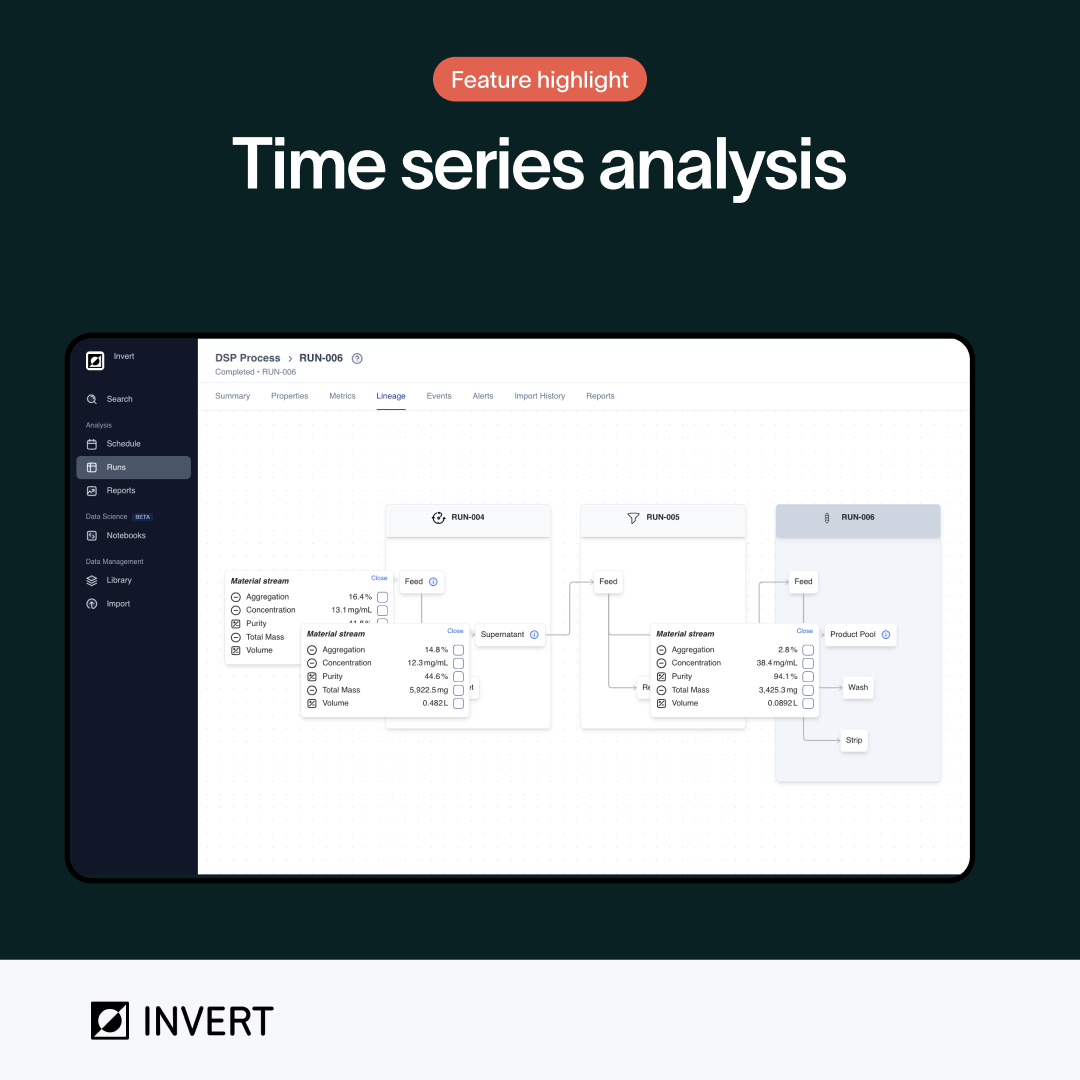AI in Bioprocess Quality Control: Moving from Compliance to Confidence

Quality Control Is the Backbone of Bioprocessing
Quality control protects patients, products, and entire manufacturing programs. It ensures that every batch meets the standards required for safety, purity, and potency. Yet QC remains one of the most manual and resource intensive parts of bioprocessing.
Data lives in spreadsheets, isolated instruments, paper notebooks, and disconnected LIMS systems. Investigations take days. Release testing slows production. Even minor misalignments in data or metadata can lead to repeat testing or batch rejection.
The result is a system that focuses more on catching errors than preventing them.
AI powered bioprocess quality control software is changing this dynamic. It provides a path from reactive compliance to proactive, data driven confidence.
The Real Bottleneck: Fragmented QC Data
QC teams rely on a wide range of data sources. These include:
- In process analytics
- Environmental monitoring
- Chromatography and assays
- Manual checks and sampling
- Equipment logs
- Electronic lab notebooks
- Stability and release testing
- CDMO data packages
When these datasets are siloed, several problems occur:
- Investigations take far longer than necessary
- Root causes remain unclear or incomplete
- Batch release slows due to manual review
- Deviations are detected too late
- Data integrity is harder to prove
- Cross functional collaboration becomes strained
Most QC teams know that the issue is not lack of data. The challenge is lack of accessible, contextualized, real time data.
How AI Strengthens Quality Control
AI powered QC platforms are not replacements for human expertise. They are tools that make quality teams faster, more reliable, and more confident by giving them comprehensive and continuous visibility into process performance.
Key benefits include:
1. Real time anomaly detection
Machine learning models monitor process data continuously. When a pattern begins to drift, the system highlights it before it turns into a deviation. QC teams can act early, reducing risk and preventing rework.
2. Automated data harmonization
Instead of hunting through mismatched parameters and inconsistent metadata, the platform harmonizes data automatically. This ensures that QC teams review unified, clean data that can be trusted.
3. Transparent AI insights
High quality QC platforms provide explainable models. Users can see why the system flags a result or recommends a next step. This transparency is essential for maintaining regulatory trust.
4. Faster investigations
With harmonized data and real time visualization, deviation investigations move from days to hours. Teams can identify the source quickly because all data lives in one accessible environment.
5. Stronger manufacturing partnership
QC no longer operates at the end of the process. With live insight, QC teams can collaborate more closely with PD, MSAT, and manufacturing.
Quality Control in Cell Therapy: A High Stakes Use Case
Cell therapy manufacturing places even greater demands on QC. Patient specific materials, variable donor profiles, compressed timelines, and sensitive cell handling introduce significant risk.
QC teams must maintain strict control over:
- Incoming material variability
- In process attributes
- Cell viability
- Media and supplement consistency
- Environmental monitoring
- Critical gene expression patterns
- Release testing
AI powered QC platforms give cell therapy teams the advantage of live data, faster deviation identification, and automated traceability. These tools help maintain consistency even when biological variability is unavoidable.
The Importance of GxP Compliance and Data Integrity
AI in QC raises an important question. How can teams use advanced analytics while remaining compliant with GxP and 21 CFR Part 11 requirements?
Modern AI ready platforms protect data integrity through:
- Traceability for every data transformation
- Access controls and audit trails
- Time stamped and version controlled datasets
- Validation pathways that map model behavior
- Clear documentation of AI logic and assumptions
- Reproducible outputs that can stand up to regulatory review
These safeguards ensure that AI strengthens rather than threatens compliance.
Invert’s platform was built from the ground up with these principles in mind. The result is a system that offers advanced intelligence while protecting the trust and reliability needed for regulatory success.
Building a Strong QC Foundation With Integrated Data
Better QC begins with better data. When data is unified and contextualized, quality teams can review the entire process with a single pane of glass.
An integrated QC data environment should include:
- Continuous ingestion from instruments, historians, and CDMOs
- Harmonized naming and metadata
- Context enriched datasets
- Real time dashboards and alerts
- Searchable historical records
- Configurable review and approval workflows
This foundation turns QC into a connected, insight driven function rather than a siloed, reactive department.
How AI Improves Decision Making for QC Teams
With the right dataset and intelligence layer, AI supports QC teams by:
- Predicting drift in critical quality attributes
- Identifying correlations between parameters and outcomes
- Highlighting non obvious sources of variability
- Supporting trend analysis across large batches
- Reducing the noise that slows investigations
- Increasing confidence in final release decisions
These capabilities free QC scientists to focus on interpretation and oversight rather than manual data work.
QC Without Data Burden: The Invert Approach
Invert delivers a unified, real time environment where QC teams can access harmonized, traceable data that supports faster analysis and clearer decision making.
Key advantages include:
- Transparent AI that supports rather than replaces expertise
- Real time monitoring across upstream and downstream operations
- Automated data harmonization for consistent reporting
- Complete lineage and traceability
- Fast deployment that minimizes IT effort
- Support for regulated environments and validation workflows
This combination helps QC teams shift from compliance driven back end review to confident, proactive oversight.
The Future of Quality Control Is Proactive, Not Reactive
The bioprocess industry is moving toward continuous monitoring, real time optimization, and autonomous decision support. QC must evolve alongside it.
AI enabled QC will allow teams to:
- Detect deviations before they occur
- Maintain consistency across sites and CDMOs
- Reduce the cost and time of investigations
- Increase confidence in batch release
- Support digital twins and advanced analytics
- Build a culture of continuous improvement
The shift from compliance to confidence requires a strong data foundation and an intelligence layer that supports scientific reasoning. Invert brings these capabilities together in one platform designed for the future of bioprocessing.
Learn how Invert’s bioprocess quality control software helps teams streamline QC, improve consistency, and maintain trust in every decision.
.png)
Engineer Blog Series: From Bioprocess to Software with Anthony Quach
Welcome to Invert’s Engineer Blog Series — a behind-the-scenes look at the product and how it’s built.In this post, software engineer Anthony Quach shares how his career in bioprocess development led him into software, and how that experience shapes the engineering decisions behind Invert.
Read More ↗
Connecting Shake Flask to Final Product with Lineage Views in Invert
Invert’s lineage view connects products across every unit operation and material transfer throughout the entire process. It acts as a family tree for your product, tracing its origins back through purification, fermentation, and inoculation. Instead of manually tracking down the source of each data point, lineages automatically show material streams as they pass through each step.
Read More ↗
Engineer Blog Series: Security & Compliance with Tiffany Huang
Welcome to Invert's Engineering Blog Series, a behind-the-scenes look into the product and how it's built. For our third post, senior software engineer Tiffany Huang speaks about how trust and security is a foundational principle at Invert, and how we ensure that data is kept secure, private, and compliant with industry regulations.
Read More ↗